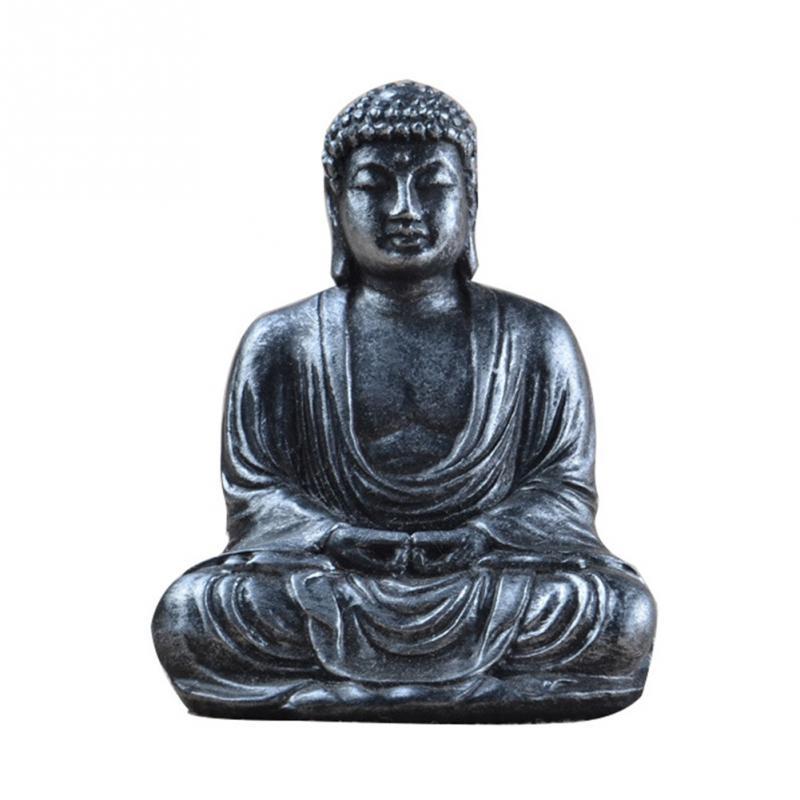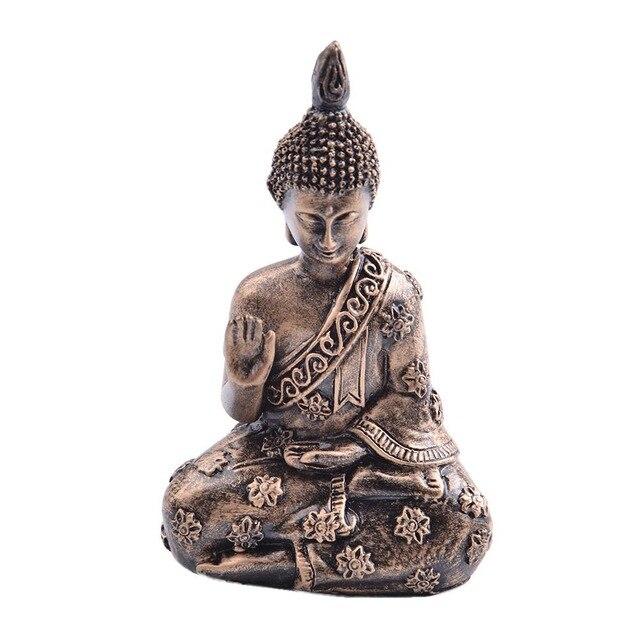Lucky Buddha Statues: Which Model to Choose?
Statues of the Buddha are placed in homes, temples and altars around the world. While most of us see them as mere decorations, others know they hold great powers.
Already, placing a representation of the Buddha in a room immediately gives it a calmer, more serene atmosphere. Even if the weight of symbolism and our mental representations necessarily plays a big role, these effects arise from very concrete things which we will talk about in this article.
Concretely, this type of object has a very real effect on the energies that surround us, but also on those that inhabit us.
In short, if you are looking for a decoration to add to your interior, a statuette of a lucky Buddha could be a wonderful idea. So let's start immediately with a focus on the different positions that our Buddha can take.
Contents :
Different positions, for our lucky Buddha
Most of the Buddha statues that we can find show him in the same position: legs crossed, chest straight and face calm.
However, there are some notable differences which, although they may go unnoticed by laymen, carry real messages that we need to understand!
Here we are going to focus on the position that our lucky Buddha will take… or rather on the activity that he is doing.
As we will see, this is really loaded with meaning.
Indeed, Buddhism is a religion with very rich beliefs which seeks to send us messages via particular symbols. This is so true that we have dedicated an entire collection to this spirituality (which you will find here) in which we are precisely interested in these symbols.
In short, if we don't want to miss these lessons, we really need to pay attention to the smallest details.

The meditating Buddha (position of harmony)
Without too much surprise, this type of Buddha statue will be perfect for places dedicated to meditation.
If you have a favorite room in your home where you like to spend time, now you know what to place there!
The meditating Buddha is indeed perfectly suited to calm and harmonious places.
With his legs folded cross-legged, his peaceful face and his clenched fists placed one against the other, this way of representing the Buddha inspires a certain feeling of balance. So look at this statue of the Buddha in deep meditation and tell us if it doesn't inspire such ideas in you!
This position is in fact the one in which he meditated most often, and the one that most branches of Buddhism advise their followers.
Truly, there are few postures as powerful as this.

The Teaching Buddha (preaching position)
Often, sculptures and representations of the Buddha show us at a particular moment in his life.
As the name suggests, the Teaching Buddha teaches. That was easy to guess.
However, it all becomes more interesting when we are interested in what he is trying to convey...
Just after attaining enlightenment, the Buddha actually began to transmit his "discoveries" about the world about life to those around him at the time in the most tremendous discourse of his entire life.
For many, this event marked the birth of Buddhism.
In any case, one thing is certain: seeing a lucky Buddha teaching is synonymous with the transmission of wisdom.

The admiring Buddha (position of contemplation)
When he is depicted with his two arms crossed placed against his chest, his palms facing him, the Buddha's position is then associated with contemplation.
Seeing it like this symbolizes determination, silent calm and acceptance of the world. Also known in Japanese Zen and Feng Shui, this position is that of serenity, of spiritual awakening achieved through calm and peaceful observation.
For the record, this position is very appreciated by monks and meditation practitioners who seek to increase their confidence and humility.
To also decorate, certain statues of admiring Buddha made of resin, bronze or wood are sold at high prices. Yes, a small Buddha can be a very decorative object!
In any case, contemplation is one of the bases of this type of spiritual practice. If you want to delve deeper into the subject, here is an extract from a document which deals with meditation from certain branches of Buddhism.

The Medicine Buddha (healing position)
When we experience health problems, we all seek to heal by any means available to us.
Even if these are by no means miraculous promises, it remains undeniable that spirituality can help us endure certain trials.
As such, this particular lucky Buddha associated with medicine has a unique meaning. With his hand facing the ground and a bowl filled with plants and herbs in his left hand, he represents healing through the application of medicinal knowledge.
Many doctors in India place a statue of this type in their office in order to benefit from the blessings it brings them.
Associated with incense, certain precious stones (quartz, tiger's eye and others) or symbols of health and abundance, the healing has already begun!

The praying Buddha (communion position)
We cannot approach the subject of lucky Buddhas without talking about prayer.
Before being the founder of one of the most widespread religions in the world, the Buddha was in fact a simple man who experienced enlightenment through a practice resulting from prayer and meditation. To represent this accession to nirvana, many sculptures only show the head of Buddha, with his serene and peaceful face.
When he prayed with his hands, it was a sign to the outside world of his great devotion. This also allowed him to better harmonize with the universe and “synchronize” with the intention of other believers.
The energy that emanates from this type of statue of the Buddha praying is therefore very special. In particular, it will match perfectly with places dedicated to prayer, such as temples or Buddhist altars.

The Buddha touching the earth
You must suspect: seeing a lucky Buddha touch the earth is not something trivial, far from it.
In fact, when this prophet first achieved enlightenment, he touched the earth with his fingertips, letting his hand gently and discreetly slide over his knee, in order to re-anchor himself into our physical world.
The effects of this representation of the Buddha will be to ground us more deeply in reality. This will then result in increased compassion, joy and kindness.
Some also like to say that, through this movement, the earth itself was the very first witness to the Buddha's enlightenment.

The importance of hands for Buddha statues
We were interested in the meaning that the lucky Buddha can take on depending on its position and its activity, but this is not the only criterion to take into account. The way the Buddha places his hands is another meaningful factor.
Known in Buddhism under the name of “mudra” (you will find a definition of this term here), the position of the hands has even been a subject of study by certain sages who were able to detect great powers through some of them. they.
It is precisely these that we will focus on now.

The Karana mudra: protection against evil
This hand gesture is used by Buddhists around the world to fight evil spirits, ward off evil and repel negative energies.
It technically consists of one hand placed in front of you, with the index and little fingers raised while the other fingers are folded on the palm.
In India, lucky Buddha statues won't be the only ones you'll see doing this mudra: many other Hindu gods also do it when depicted fighting evil.
Through its “demon catcher” effect, this gesture brings luck and makes the image of the Buddha a great symbol of protection.

Abhaya mudra: courage and fearlessness
This mudra is undoubtedly the most popular and widespread in Buddhism.
Believed to bring strength and courage to those who view it, many monks place their hands in the Abhaya mudra position when meditating outside their temples.
In a way, they “bless” the women and men who cross their path. This gesture therefore contains great ideas of generosity, kindness and gratitude towards the world.
Moreover, you too will be able to benefit from such gifts by placing a statue of the Buddha making this gesture (such as this one) in your home.

The Anjali mudra: respect and greeting
Every culture has a particular gesture used to greet others. In Buddhism, this function is occupied by the Anjali mudra.
Made by placing the palms together at heart level, with the fingertips pointing toward the sky, the Laughing Buddha (a representation of Bodhisattva from China) often uses it to show his openness, benevolence and good nature.
It goes without saying that this mudra is seen as in Asia as a great mark of respect towards others, but also towards the universe.
Figurines of Buddha placing his hands in this way will therefore have their place at the entrance to our homes, temples and businesses where he will “greet” all those who enter.

The Dharmachakra mudra: transmission of wisdom
If there is one thing that practitioners seek when they are interested in statues of the lucky Buddha, it is the transmission of wisdom (and, to another extent, the attainment of inner calm and peace).
With the middle finger of the right hand meeting the thumb and index finger (forming a circle) of the left, the shape thus created is mysterious and quite complex to understand.
Simply put, this gesture is supposed to represent the "wheel of Dharma", one of the most widespread symbols in Buddhism used to express the idea of the cycle of reincarnations.
To learn more about this very particular oriental concept, here is an article that deals with reincarnation in the Buddhist tradition.
In short, it is said that one of the ways to break this infinite cycle is to have sufficiently great wisdom, hence the idea of transmission associated with this mudra.

The Dhyana mudra: balance, clarity and energy
Last but not least, the Dhyana mudra is very appreciated by those who practice meditation diligently.
This is indeed a basic position of many types of Buddhist meditation. Along with that of the lotus and the seiza, it is in fact one of the most popular.
Apparently, by placing the back of our right hand on the palm of the left in this way, with our thumbs touching, energies can flow within us in a special way.
All of this promotes the states of calm, relaxation, and clarity of mind necessary for most spiritual practices. In any case, this is why the Buddha practiced this mudra.
Combined with a Zen atmosphere and thoughtful interior decoration, this representation of the Buddha will change the atmosphere of an entire room.
Lucky charms featured in this article

Statue of the Buddha in Meditation
See more
Indian Buddha Statuette
See more
Statue of Buddha Doing Abhaya Mudra
See more

